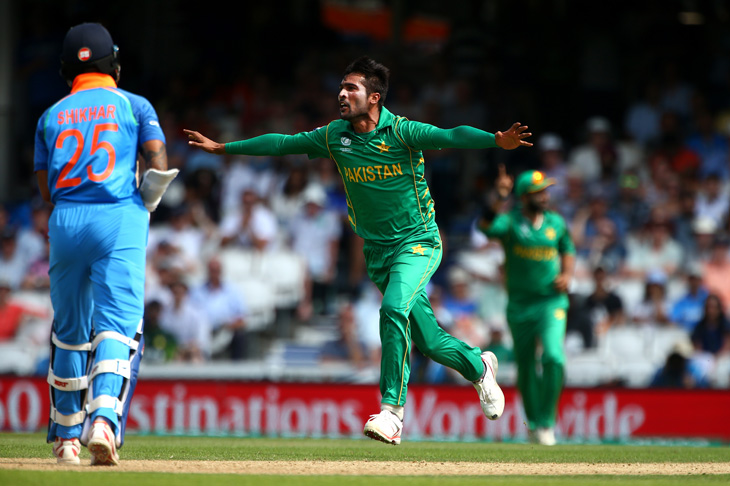The Pakistan supporter was festooned in cream and green, and carried a chalkboard round his neck with the legend: ‘My wives think I’m at the mosque.’ By the end of the day he was a very happy man, along with millions of others both here and on the subcontinent. Pakistan’s astounding victory in cricket’s Champions Trophy was redemption on an epic scale, both for the team and its most lethal player. In a field of eight they qualified in last place. Shortly after just making the cut in 2015 they lost to Zimbabwe: had that defeat come a few days earlier it would have been West Indies rather than Pakistan in the tournament. And you can bet your life West Indies would have come nowhere near the final, let alone winning it.
The leading bowler last Sunday was Mohammad Amir, who struck out India’s renowned top order in just a few overs. Six years ago, Amir was led away to prison after being the victim of a particularly nasty newspaper sting. Now older, smarter, fuller in beam and body, he fired down his left-arm seam that was almost unplayable.
At 8 a.m. there were 5,000 fans waiting at the Oval; the ground could have been filled many times over. This was sport at its finest: an intense national rivalry, enacted on the field with ferocious but fair intensity; in the stands passion, pride and friendship. These were supporters mixing happily, humorously and loudly. The woman in the sari wore her England cap back to front to keep the sun off her neck. The drummers in Beefeater uniforms pounded away. Even the boxer Amir Khan popped up to say he hoped it would drive more young people to take up cricket.
I have been to play cricket in Pakistan and have seen how obsessed the country is. I can only imagine how this extraordinary victory would have played in Karachi and Lahore, or the mountains of Chitral. At a particularly nasty time for the world, how good to see sport bringing nations and people together. What a game. What a match. What a result.
It’s grass court time again, and happy birthday Wimbledon, 140 years old this year. Until recently three of the four grand slams were played on grass. Now grass court tennis is almost an anachronism, clinging on only because of the mighty place that Wimbledon has in tennis history. It is almost entirely isolated in the north-west corner of Europe by the steady march of hard and clay court tournaments. Only two grass tournaments — in Turkey next week, and in Newport Rhode Island the week after Wimbledon — take place outside. Players pay lip service to it; but do they actually like it? Certainly they have stopped playing the traditional grass game of serve and volley.
Wimbledon and Queen’s are at the heart of the English summer season, and maybe that is why Britain is so poor at tennis (with the exception of Andy Murray, who had to leave for Spain as a teenager). How come we stage the world’s most famous tennis event, and yet really only have Murray as a homegrown star? Is it because Wimbledon has become too much of a social gathering for the glamorous, rich and famous, all ogled by those who have to queue to buy tickets?
This year Murray — despite being knocked out in the first round of Queen’s — still has the chance to equal Fred Perry’s three Wimbledon men’s titles. Perry was the first working-class player to make a serious impact on British tennis but his extraordinary feats (he is the only Brit to have won all four Grand Slams) were not the breakthrough many expected. Perhaps the spirit of Miss Joan Hunter Dunn, ‘furnish’d and burnish’d by Aldershot sun’ and the heroine of John Betjeman’s poem, still lives on in British tennis.







Comments